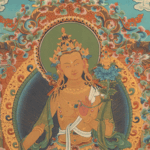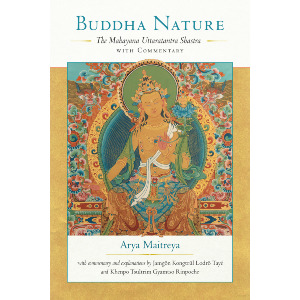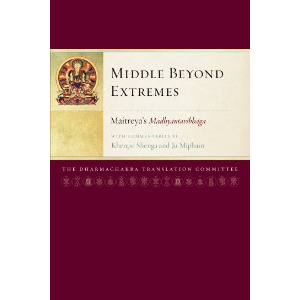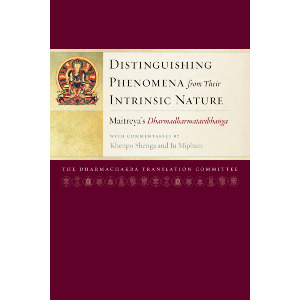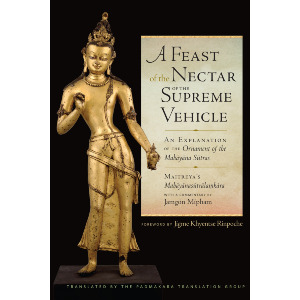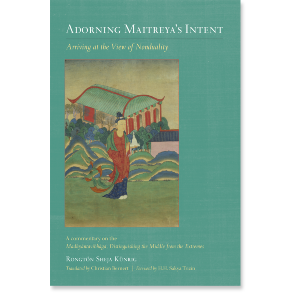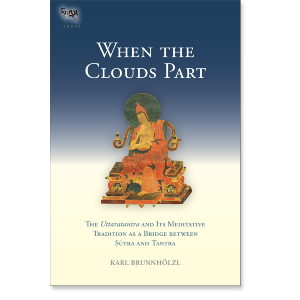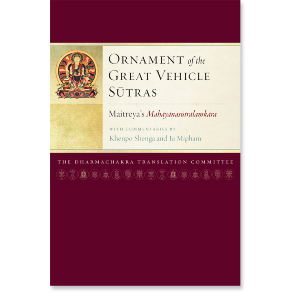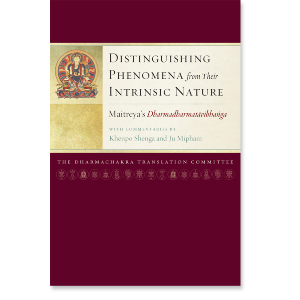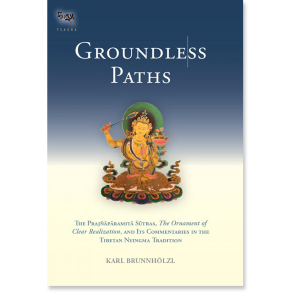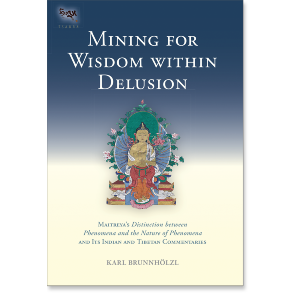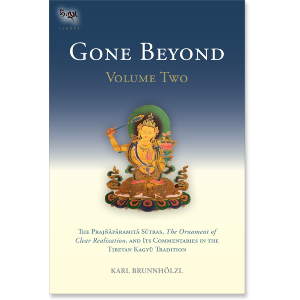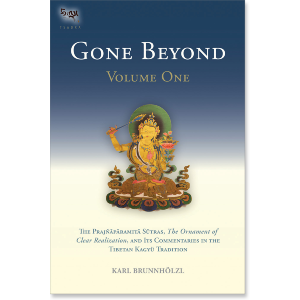| The following article is from the Autumn, 2000 issue of the Snow Lion Newsletter and is for historical reference only. You can see this in context of the original newsletter here. |

BUDDHA NATURE
Khenpo Tsultrim Gyamtso comments on Maitreya's Mahayana Uttaratantra Shastra
BY VICTORIA HUCKENPAHLER
Who better to comment on the Buddha Nature than one who inhabits the realm of non-duality? Khenpo Tsultrim Gyamtso, a respected Kagyu scholar-yogi, is one such being whose sublime vision breathed life into the teachings he recently gave at Kagyu Dorje Kyungdzong, Ven. Lama Norlha's retreat center in Charlottesville, VA. Besides building a nunnery, school, and retreat center for Tibetan women in Nepal, founding the Marpa Institute for Translators, and serving as spiritual advisor for the Dzogchen Ponlop Rinpoche's Nalandabodhi network of Dharma centers, Khenpo Tsultrim has recently authored extensive explanations of Jamgon Kongtrul Lodro Thaye's commentary on Arya Maitreya's Mahayana Uttaratantra Shastra (published as Buddha Mature by Snow Lion Publications, 2000). The latter represents one of the famous Five Treatises which the Buddha Maitreya transmitted to Asanga in the Tushita Heaven, following Asanga's twelve years of arduous retreat.
In Charlottesville, Khenpo Tsultrim graciously consented to speak with me about the importance of the ancient text, its relevance to our time, and his motivation for annotating it. To begin, I asked Rinpoche why he chose to comment on this work of Arya Maitreya In response, he told me,
There are many translations of texts written from the Rangtong (literally, empty of self i.e., all phenomena have no true existence) point of view, but few from the Shentong (empty of other, i.e., reality is the inseparable union of emptiness/ cognizance) view. This text focuses precisely on the latter. It is good to start one's study with the Rangtong view, which asserts that since all phenomena are neither one nor many, they have no essence. But having understood that nothing is immutably real, it is good to go on to the Shentong view, which states that mind is not mere emptiness, nor the pacification of all conceptual fabrications, but is instead luminous, brilliant, clear light, free of imperfection. This is especially important nowadays when people often confuse the Rangtong view with nihilism. They hear that the ultimate nature of reality is beyond concept, beyond all relative appearances, just like an illusion or a dream, and they feel that the nature of mind is nothingness. But when they encounter the Shentong view, which emphasizes the luminous clarity of the mind possessed of all the inconceivable qualities, they are more satisfied. Nor is the Shentong view something fabricated just to make people happy! It is soundly based, and laid out in the first chapter of Maitreya's root text through three reasons, ten explanations, and nine examples. The second chapter explains how enlightenment results from meditating on the Buddha Nature; the third chapter outlines the benefits of enlightenment and its sixty-four qualities; the fourth chapter describes how it is possible, though inconceivable to us, that the Buddha can bring limitless benefit to others while remaining in the non-conceptual state; and the final chapter explicitly details how the benefit of hearing just one word of this treatiseeven if you don't understand it!surpasses that of practicing the Six Paramitas [Perfections] for aeons.
This treatise has great meaning for those following either the Mahayana or Vajrayana path, but usually texts pertaining solely to the latter require that one receive an empowerment. That is not the case here. Buddha Nature is beneficial to alleven to non-Buddhists. In particular, it can help modern scientists who have done subtle research into the nature of sub-atomic particles, but little study on the nature of mind. The way in which this text is composed is very accessible to readers because it includes a brief introduction, extensive explanation, and concluding summary. It is therefore an important book for this time.
Seated on the Lama's throne, Khenpo Tsultrim Gyamtso is clearly in his element. His mastery of his topic, both scholarly and experiential, gives the audience the sense of being transported back to one of the great Indian monastic universities of the sixth century. During the course of the five sessions that ensued, Khenpo Rinpoche stressed that the Buddha's Second and Third Turnings of the Wheel of Dharma differ, yet do not contradict each other. He expanded on the text's principal points: the three reasons why all sentient beings possess the Buddha Nature, the ten aspects of the Buddha Nature's existence, and the nine examples of how Buddha Nature can be present within us, yet obscured from us. In the Second Turning of the Wheel, Khenpo Tsultrim explained, the Buddha proclaimed that all phenomena from the grossest form on up to the mind of the Buddha are empty because they are not one or many, both or neither. So nothing has any essence and nothing exists. All appearances merely come about dependency through causes and conditions. Later, Nagarjuna clarified this point in his Fundamental Treatise on the Wisdom of the Middle Way in 25 chapters. People kept coming up with new reasons why things exist, so he had to keep writing new chapters refuting their belief in existence! But in the Third Turning the Buddha stated that the Buddha Nature is the essence of all beings; however, because we don't know that this nature pervades all equally, like butter existing in milk, we engage in faults, such as thinking we don't have the ability to attain enlightenment, or that some beings are superior to others. Do the Buddha's two positions contradict each other? No. The Third Turning was presented to counteract our tendency to these faults. Nor did the Buddha posit the existence of Buddha Nature just to make us feel good. He wasn't teaching that something that doesn't exist exists. In reality, only because the Buddha Nature exists do faults represent problems. The fact that we all long for peace is the sign that we have enlightened mind, otherwise we would have no wish for peace and no aversion to suffering.
Khenpo Tsultrim Gyamtso's conviction of the fundamental perfection underlying defiled appearances momentarily transmitted itself even to minds dense with obscurations. Events which would dishearten others for him become markers pointing directly back to the ultimate reality which is their base. Those hostile to the Dharma, he said, in a veiled reference to the Communist Chinese, can ultimately become great disciples like Angulimala [a seeker who killed 999 men before embracing the Buddha's Path]. And the destruction of monasteries is not all bad. It allows a new generation to acquire the merit of rebuilding! Besides, enemies can act as your helpers because they strengthen your practice. When asked how a practitioner could avoid the fault of seeing him/herself as superior to the non-practitioner, Khenpo Tsultrim replied, Recognize that all the beings' flaws are unrealmere confused and impermanent appearances, because actually the Buddha Nature is originally perfect. It is empty of the separable, which are the fleeting stains, but not empty of the inseparable, which are the unsurpassable qualities. How is this possible? Because the stains of confusion are not intrinsic to the essence of mind, so they can be removed, whereas the qualities of enlightenment are the nature of mind, so they cannot be removed. The Heart of Wisdom Sutra said there are no stains and no freedom from stains. This can be seen through the example of dreams: if you dream that you are dirty and then take a bath, you later realize that because it was a dream, there never were any stains; therefore there was no true removal of stains.
Khenpo Rinpoche further transmitted a glimpse of primordial perfection when speaking of the ten aspects of Buddha Nature's existence, among which is fruition, encompassing the transcendent perfection of the qualities of purity, bliss, self, and permanence. Transcendent purity, he stated, goes beyond pure and impure; likewise, the transcendence of happiness and suffering is genuine bliss. That which is beyond self and selflessness is the genuine self, which is not to be confused with the Hindu notion of a permanent self, or atman. And the transcendence of a notion of permanence and impermanence is genuine permanence. It's like that.
A parallel theme was the inconceivability of a Buddha's qualities, beyond the grasp even of a tenth-level Bodhisattva. Continuing with the ten aspects of Buddha nature, Khenpo Tsultrim spoke of manifestation, which has three phases, or ways in which beings relate to their Buddha Nature: ordinary beings relate mistakenly; Bodhisattvas relate unmistakenly; and Buddhas relate in a manner beyond conception. Again using the dream analogy, Khenpo Tsultrim stated: If someone dreams and doesn't realize he is dreaming, he is relating to his dream mistakenly; if he dreams and knows he is dreaming, he relates to his dream unmistakenly; and if he realizes the ultimate nature of his dream, he rests in the reality beyond conceptual fabrication. The Buddha is inconceivable like the sky. We assign the sky a center and boundary according to our range of vision, but in reality it is limitless. In fact, all things are inconceivable; you really can't describe them. For example, there is no agreement globally on what time it is. Different perceptions of time are accurate according to where one is. And the fact that we can see TV images broadcast miles away shows that near and far are also relative. So everything is inconceivable, but the Buddha is super-inconceivable!
At this and many other junctures throughout the teachings, Khenpo Tsultrim called upon his unique translator, Ari Goldfield, to sing a Mil- arepa doha (song of realization). One cannot experience the full scope of Rinpoche's teaching without factoring in Ari, who not only renders Khenpo Tsultrim's commentaries masterfully, but appears to have memorized the entire compendium of Milarepa's songs! Belting them out like a Broadway proto the amusement even of the Lamahe shatters preconceptions of how Dharma should be presented. Gaining momentum from his own enthusiasm, he ran, indefatigable through verse after verse, sometimes punctuating them with a resounding yeah! Khenpo Tsultrim places considerable store in these songs. The tradition of singing is important in Vajrayana ritual, he remarked. We sing these profound words because they give us a chance to meditate on their meaning. Some Westerners don't like to sing. It reminds them of church. But in Tibet there is a saying, The Buddha and ordinary beings both walk on two legs,' meaning: everything is a bit alike. So if they sing beautiful songs in church, why can't we here? Milarepa himself said, Singing is the extraordinary tradition of this lineage.'
Intellectual brilliance and perseverance alone cannot fully account for the interaction between Khenpo Tsultrim and Ari, which goes beyond that of teacher and translator, master and disciple. There is something inscrutable in their pairing, as if an unseen agency has ordained that by updating Milarepa's message, Ari would make it more accessible than the Lama alone could do. Following a bravura lunch-break performance in which, at Khenpo Tsultrim's request, Ari danced and pantomimed his way through doha after doha, he kindly consented to comment on his association with the Lama: The songs are Lama's unique gift, he said. Westerners tend to be very serious, so he gets everyone singing to lighten them up. He wants people to experience the joy that is part of the Dharma He is also rare in combining scholarship with yogic meditation. The two are seamless because he applies everything he studies. In Tibet he spent years doing solitary retreat in caves, sometimes sealed in darkness for no one knows how long because time wasn't measured. I have traveled with him since 1995 and have seen the extent of his compassion. He can teach so many different types old and young, European and Asian, people of all lineagesand he is able skillfully to adapt his presentation to each. He travels eight months a year, but he demonstrates equanimity in the face of whatever arises. In fact, he delights in adversity because difficulty for him is self-liberated; it is just a concept. For this reason he is able to show students that their perceived limits are just that imagined. In reality they can do so much more. As for himself, he is constantly practicing diligence. He doesn't go to bed before midnight and he is up very early. When asked if Khenpo Tsultrim, who refers so frequently to Milarepa, might in fact be his emanation, Ari, who has clearly picked up the Lama's evasive ways, merely smiled charmingly and said, That depends on the degree of the student's enlightened perception.

We are living on a I planet with no top and no bottom, in space which has no begin; ning or end. So isn't it easy to see that it's all a dream?
Whether or not Khenpo Tsultrim is Mila's twenty-first century manifestation, he lives in, and is able to communicate, the nature of mind beyond concepts. Look directly at the nature of mind, he said, when guiding the assembly through several meditation sessions. You will see that the clear light is its perfectly existent nature. This connects with the views of Mahamudra and Dzogchen which both say that the mind is primordially pure. Nothing needs to be added because the Buddha qualities are all perfectly present in the nature of mind. Rest in the non-conceptual state. Bringing the latter within easier reach, he cited an example of how replacing one emotion with another can bring about relative non-conceptual- ity: If you are really angry, you forget thoughts of fear. You can even face death and it makes no difference. You are then in the non-conceptual state. Joking, he added, Sometimes this can be deadly. A man in India won the lottery, and he got so excited that he entered a non-conceptual state: he died!
Sitting at this scholar-yogi's feet, I was reminded of the unparalleled good fortune of this generation of practitioners, doubtless the last to encounter meditators raised in the ancient traditions of pre-Communist Tibet. Hopefully, the lineages will continue in new, valid ways, but future students will not be studying with masters who, like Khenpo Tsultrim Gyamtso, practiced Chod for years in charnel grounds. Yet attachment even to this good fortune must be transcended. As Khenpo Tsultrim concluded, We are living on a planet with no top and no bottom, in space which has no beginning or end. So isn't it easy to see that it's all a dream?

